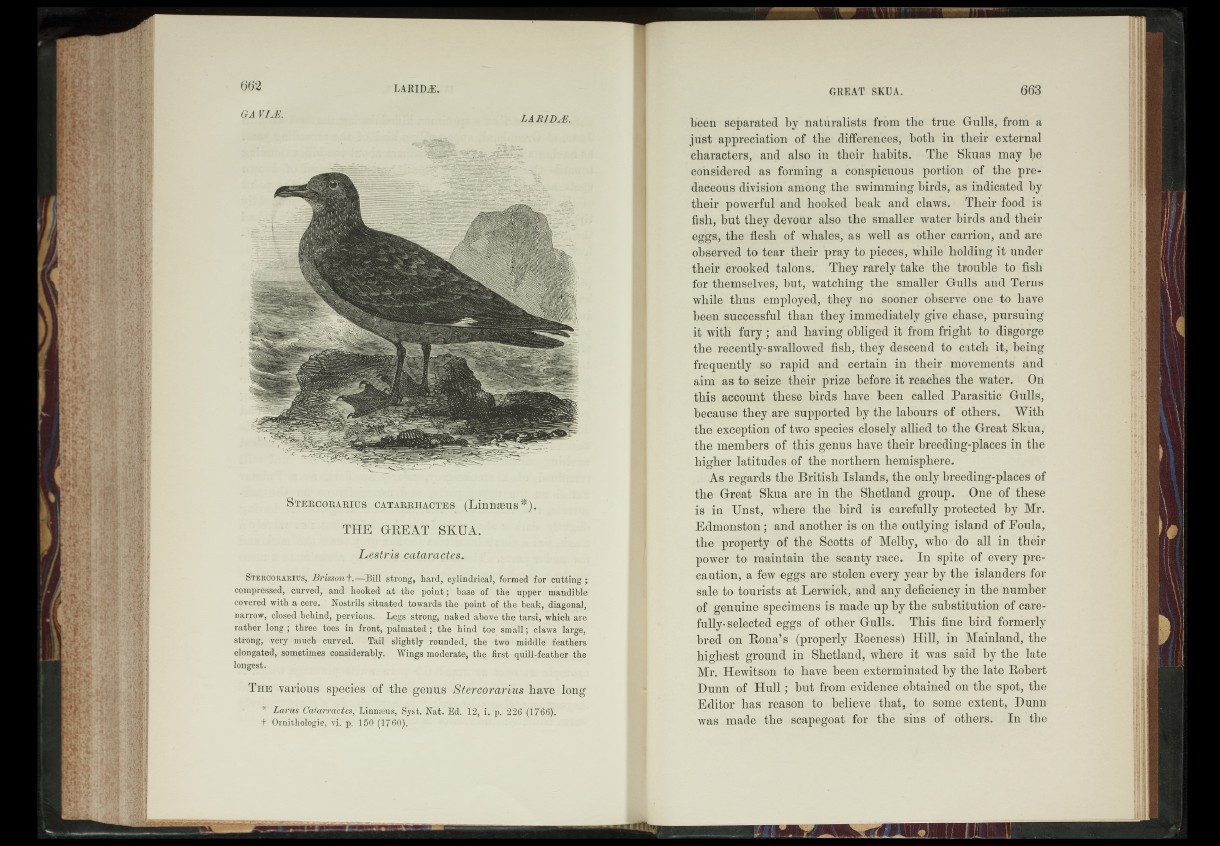
tf 4 VUS. : L ARID JE.
Stercobarius C4TAKBHACTES ^(Linnseus
THE GREAT-' S ^ ö S .
Lpstr/% Ga^j^agfgs
Sterooraetüs, ifraiow ^BjpïSifl 'strong, .:hard,%yïfrdTicaf, formed for cutting
compressed,, curved, and. hooked atathe point; base»oM?the: upper, mandible
covered .with a cere.' [ Nostrils situated towards the-beak, .diagonal,
narrow^ closed -behind, pervious.. Legs strong,_nak eaabove the ’tarsi, which are’
rather long y three toes in front, palmated ; fhe^liind* toe small; claws large,
strong, ydry imn'ch carved.-• Tail slightly 'roundédj* thé >twó^-middle? feathers
elpngated,:-sometimes considerably. Wings moderate, ,th& firs£_ quill;feajtbfr-the-
longest.-
The various^ spe’cies'tof 4he~*getóifl‘#«»rc«y^ïè«i have »long
*’ DarusVatarractes; Iinnreus, SysLUat/E<I jl’S. 6 \ l f“ 6 if. '
t OrnitBolOgie/ vi.-p. |
Keen separates by naturalists from the true Gulls, from a
just appreciation of-the* differences, both in their external
characters, and also in their habits. The Skuas may be
considered as forming a conspicuous portion f of the predaceous
division among the swimming birds, as "indicated by
tbeir/póWerful andrbobked. beak and claw’s. -Their'food is
fish-, but they devour also, the smaller water birds and their
eg'gs, the flesh of whales, as -well as other carrion, and are
observed to tear their pray, to pieces, while; holding it* under
their" brooked talons;: They rarely "-take the trouble *&> fish
for thêih‘selyës/.but, watching the smaller Gulls and Terns
while thusr employed, • they ■ no .sooner observe-one*-to have
beeh successful than they immédiatelyrgive chase,' pursuing
it witH fury ; and having obliged it“ from fright to disgorge
the recently* swallowed fish, they descend tV'cateh - it, -being
frequently .so."rapid, and certain in their^movements and
aim "as to seize prize before it, reaches the waters: Oh
this account birds have, been called Parasitic iSulié^
because they are- supported by"the labours' ofo others With
the'exception Off wo species-closely alliéd-tb the Great Skiia,’
the members of this genus have their breeding-places in the
higher latitudes .of the northern hemisphere1/ :
. As regards the. British Islands, the only breeding-places of
the , Great Skua are in the Shetland ’group. One of these
is-in Uns.t/‘ where the'bird is carefully protected by Mr.
Edmonstpni; and another is-Ion the: outlying, island : of Foula,<
the^property - ó f the-iScottS'óf-^Melbyi who''do-all in their
poweiute^maintainfiihe^scanty race. In spite" of every precaution,
a few -e^g4;are:stolen every year by the islanders for
sale.to touristsi at Lerwick, and any*.defieiencj in the number
©f, genuine specimens !^ made üp by the"substitution of bare-1
fully-selected eggs of otherTGulls. This ’ fine- bird formerly
bred on~Rona’-s (properly Roeïréss) Hill, in Mainland,-the;
highest -ground in Shetland, where it was. said b y the 'late
Mr. Hewitsobfa have been exterminated by the1 late Robert
Dunn 'of Hull ; but from, evidence -obtained on the spot, the
Editor .has; .reason.Je^belipve. that, to some extent, Dunn
was .made t^e scapegoat".for .thel sins of-others; In thé